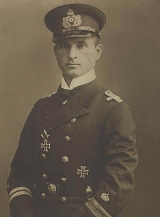
Otto Weddigen
Encyclopedia
Otto Eduard Weddigen was a German U-boat
commander
during World War I
.
and started his military career in the Kaiserliche Marine
in 1901. In 1910 he was given command of one of the first German submarines, .
On 22 September 1914, while patrolling in the region of the southern North Sea
known to the British as the "Broad Fourteens
", U-9 intercepted the three warships of the Seventh Cruiser Squadron, also known as the Live Bait Squadron. Weddigen fired off all six of his torpedoes, reloaded while submerged, and in less than an hour sank the three British armoured cruisers HMS Aboukir
, HMS Hogue
and HMS Cressy
. Sixty two officers and 1,397 men were killed, only 837 survived.


 Otto Weddigen was awarded the Iron Cross
Otto Weddigen was awarded the Iron Cross
and, after sinking HMS Hawke
and some merchant ships, Prussia
's highest military order, the Pour le Mérite
. He became one of only six non-Bavarians to receive the Knight's Cross
of the Military Order of Max Joseph
, Bavaria's highest military honor. He also received the highest military honors of the other two kingdoms of the German Empire, the Knight's Cross of Saxony's Military Order of St. Henry
and the Knight's Cross of Württemberg's Military Merit Order
.
Weddigen died while commanding the submarine . On 18 March 1915 U-29 was rammed by the British battleship HMS Dreadnought
in the Pentland Firth
. U-29 had broken the surface immediately ahead of Dreadnought after firing a torpedo at HMS Neptune and Dreadnought cut the submarine in two after a short chase. There were no survivors from the submarine.
U-boat
U-boat is the anglicized version of the German word U-Boot , itself an abbreviation of Unterseeboot , and refers to military submarines operated by Germany, particularly in World War I and World War II...
commander
Commander
Commander is a naval rank which is also sometimes used as a military title depending on the individual customs of a given military service. Commander is also used as a rank or title in some organizations outside of the armed forces, particularly in police and law enforcement.-Commander as a naval...
during World War I
World War I
World War I , which was predominantly called the World War or the Great War from its occurrence until 1939, and the First World War or World War I thereafter, was a major war centred in Europe that began on 28 July 1914 and lasted until 11 November 1918...
.
Biography and career
He was born in HerfordHerford
Herford is a town in North Rhine-Westphalia, Germany, located in the lowlands between the hill chains of the Wiehen Hills and the Teutoburg Forest. It is the capital of the district of Herford.- Geographic location :...
and started his military career in the Kaiserliche Marine
Kaiserliche Marine
The Imperial German Navy was the German Navy created at the time of the formation of the German Empire. It existed between 1871 and 1919, growing out of the small Prussian Navy and Norddeutsche Bundesmarine, which primarily had the mission of coastal defense. Kaiser Wilhelm II greatly expanded...
in 1901. In 1910 he was given command of one of the first German submarines, .
On 22 September 1914, while patrolling in the region of the southern North Sea
North Sea
In the southwest, beyond the Straits of Dover, the North Sea becomes the English Channel connecting to the Atlantic Ocean. In the east, it connects to the Baltic Sea via the Skagerrak and Kattegat, narrow straits that separate Denmark from Norway and Sweden respectively...
known to the British as the "Broad Fourteens
Broad Fourteens
thumb|200px|right|The Broad Fourteens on a map by Delisle The Broad Fourteens is an area of the southern North Sea that is fairly consistently fourteen fathoms deep...
", U-9 intercepted the three warships of the Seventh Cruiser Squadron, also known as the Live Bait Squadron. Weddigen fired off all six of his torpedoes, reloaded while submerged, and in less than an hour sank the three British armoured cruisers HMS Aboukir
HMS Aboukir (1900)
HMS Aboukir was a Cressy-class armoured cruiser. She was built by Fairfield Shipbuilding & Engineering Co Ltd, Govan, Scotland in 1902.-First World War:...
, HMS Hogue
HMS Hogue (1900)
HMS Hogue was a Cressy-class armoured cruiser in the Royal Navy. Hogue was sunk by the German U-boat U-9 on 22 September 1914.-Service history:...
and HMS Cressy
HMS Cressy (1899)
HMS Cressy was a Cressy-class armoured cruiser in the Royal Navy. Cressy was sunk by the German U-boat U-9 in September 1914.-Service history:...
. Sixty two officers and 1,397 men were killed, only 837 survived.



Iron Cross
The Iron Cross is a cross symbol typically in black with a white or silver outline that originated after 1219 when the Kingdom of Jerusalem granted the Teutonic Order the right to combine the Teutonic Black Cross placed above a silver Cross of Jerusalem....
and, after sinking HMS Hawke
HMS Hawke (1891)
HMS Hawke, launched in 1891, was the sixth British warship to be named Hawke. She was an Edgar-class protected cruiser.-Service:...
and some merchant ships, Prussia
Prussia
Prussia was a German kingdom and historic state originating out of the Duchy of Prussia and the Margraviate of Brandenburg. For centuries, the House of Hohenzollern ruled Prussia, successfully expanding its size by way of an unusually well-organized and effective army. Prussia shaped the history...
's highest military order, the Pour le Mérite
Pour le Mérite
The Pour le Mérite, known informally as the Blue Max , was the Kingdom of Prussia's highest military order for German soldiers until the end of World War I....
. He became one of only six non-Bavarians to receive the Knight's Cross
Knight's Cross
Knight's Cross refers to a distinguishing grade or level of various orders that denotes bravery and leadership on the battlefield....
of the Military Order of Max Joseph
Military Order of Max Joseph
The Military Order of Max Joseph was the highest purely military order of the Kingdom of Bavaria. It was founded on 1 January 1806 by Maximilian I Joseph of Bavaria, the first king of Bavaria...
, Bavaria's highest military honor. He also received the highest military honors of the other two kingdoms of the German Empire, the Knight's Cross of Saxony's Military Order of St. Henry
Military Order of St. Henry
The Military Order of St. Henry was a military order of the Kingdom of Saxony, a member state of the German Empire. The order was the oldest military order of the states of the German Empire. It was founded on October 7, 1736 by Augustus III, King of Poland and Elector of Saxony...
and the Knight's Cross of Württemberg's Military Merit Order
Military Merit Order (Württemberg)
The Military Merit Order was a military order of the Kingdom of Württemberg, which joined the German Empire in 1871. The order was one of the older military orders of the states of the German Empire...
.
Weddigen died while commanding the submarine . On 18 March 1915 U-29 was rammed by the British battleship HMS Dreadnought
HMS Dreadnought (1906)
HMS Dreadnought was a battleship of the British Royal Navy that revolutionised naval power. Her entry into service in 1906 represented such a marked advance in naval technology that her name came to be associated with an entire generation of battleships, the "dreadnoughts", as well as the class of...
in the Pentland Firth
Pentland Firth
The Pentland Firth , which is actually more of a strait than a firth, separates the Orkney Islands from Caithness in the north of Scotland.-Etymology:...
. U-29 had broken the surface immediately ahead of Dreadnought after firing a torpedo at HMS Neptune and Dreadnought cut the submarine in two after a short chase. There were no survivors from the submarine.

